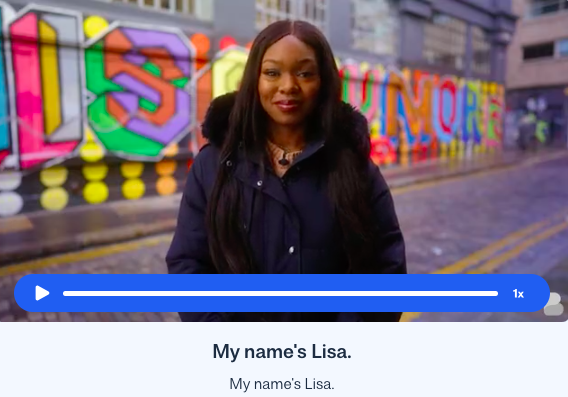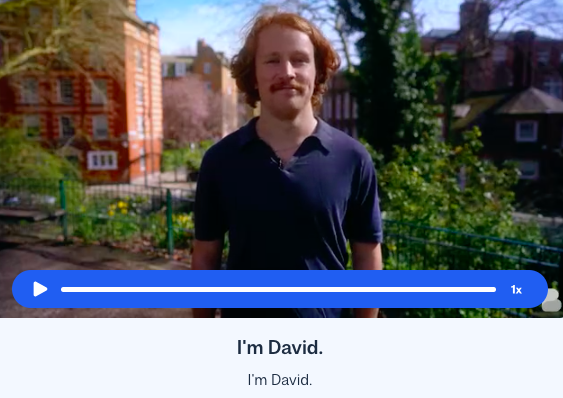A Guide to Self-Introduction in English
Learn how to introduce yourself in English with confidence, and make a great first impression.
I want to learn...
Good introductions and first impressions give you a better chance of creating meaningful connections with people. They make you more memorable, and they make people more comfortable around you. It doesn’t matter whether you’re meeting someone in a casual or business environment, you need to make a good first impression.
In this article, you’ll learn how to introduce yourself in English and make the best possible first impression.
How to Introduce Yourself in English
1. Understand the Context
Not every introduction is the same. The way you introduce yourself depends on where you are and who you’re talking to.
There are still some situations where you must be aware of tone and formality. For example, the introductions you’d use at a party or a job interview are very different.
Casual introductions
In casual situations — when you’re with friends, at a party, or meeting new classmates, for example — keep your introductions light and friendly.
Here’s an example:
"Hey, I’m Sam. Nice to meet you!"
Formal situations
In professional situations, you’ll sometimes — but not always — need to use more formal language. When talking to coworkers (or even bosses) you know well, using casual language is acceptable. But when you meet someone for the first time at a job interview, your introduction needs to be more formal. The same applies when you’re meeting new customers.
Here’s an example:
“Hello, my name is Samantha. It's great to meet you."
When it comes to formality, a lot depends on the context. Not all professional communication needs to be formal. Take cues from the people around you. If they speak formally, you should, too. But if they’re casual and relaxed, follow their lead.
2. Key Elements of a Strong Self-Introduction
A good self-introduction is simple but effective. Here’s a basic structure:
- Greeting – "Hi!" "Hello!" "Good morning!"
- Your Name – "I’m Alex." "My name is Alex Johnson."
- What You Do – "I work as a software developer." "I’m currently studying business."
- Relevant Experience (if applicable) – "I’ve been in the industry for five years."
- A Personal Touch (optional) – "In my free time, I enjoy hiking."
Introduce yourself in English with these useful phrases
Here are the most useful words and phrases when introducing yourself in English. Some of these phrases are perfect for casual situations and others for formal ones. There are some that you can use in both (Neutral) too.
Introducing yourself
- "Hi, I'm [Your name]. Nice to meet you!" (Casual)
- "Hello, I'm [Your name]. I just moved in next door." (Neutral)
- "Hey, I’m [Your name]. What brings you here?" (Casual)
- “Hi, I’m [Your name]. I’m friends with [Mutual friends’ name] too.”
- "Good [time of day], my name is [Name], and I am the [Job Title/Role]." (Formal)
- "Hello, my name is [Your Name], it’s great to meet you." (Neutral)
- "Pleased to meet you, I’m [Your Name]." (Formal)
Asking for someone’s name
- "What's your name?" (Neutral)
- "I didn't catch your name, what was it again?" (Casual)
- "May I have your name, please?" (Formal)
- "I’m [Your name]. And you are?" (Casual)
- "Could you please tell me your name?" (Formal)
Talking about your job
- "I work as a [Your job]." (Neutral)
- "I recently joined [Company] and I'm excited about my role in [Department/Project]." (Neutral)
- "I work with [Company] as a [Position]." (Formal)
- "I specialize in [Field/Industry]." (Formal)
- "I've been working in [Field] for [Number] years." (Neutral)
Talking about where you come from
- "I’m from [Your Country or City]. Where are you from?" (Neutral)
- "I grew up in [Place], but I’ve been living in [Place] for [Time]." (Neutral)
- "I come from [City/State/Country]." (Neutral)
- "I originally come from [Place], what about you?" (Casual)
- "I was born and raised in [City/Country]." (Neutral)
Talking about your interests
- "I enjoy [Activity]. Do you have any hobbies?" (Neutral)
- "Outside of work, I love spending time on [Hobby or Interest]." (Casual)
- "I’m really into [Hobby or Activity]. Do you enjoy that as well?" (Casual)
- "In my free time, I really enjoy [Activity]." (Neutral)
- "One of my passions is [Hobby]." (Casual)
Commenting on the situation
- "This is a great party, isn't it?" (Casual)
- "It’s my first time at one of these events. Have you been to others before?" (Neutral)
- "What a fantastic event this is, isn’t it?" (Neutral)
- "Have you attended this event before?" (Casual)
Complimenting people
- "That’s an interesting point of view. What made you think of that?" (Neutral)
- “I really like your dress. Where did you get it?” (Casual)
- "I must say, your expertise in [Field] is impressive." (Formal)
- "You’ve done a wonderful job organizing this event." (Formal)
- "Your work on [Project] is very impressive." (Neutral)
Finding things in common
- "Do you also find [Topic] to be challenging?" (Neutral)
- "I’m trying to meet people in [Field]. It’s great to connect with someone else who’s interested." (Neutral)
- "It seems we have [Topic/Interest] in common." (Neutral)
- "Have you always been interested in [Field/Hobby]?" (Casual)
Extending the conversation
- "Would you like to join us for coffee? We can discuss this further." (Neutral)
- "I’d love to hear more about your experiences. Maybe over lunch?" (Neutral)
- "Do you have time for a quick chat after this?" (Neutral)
- "I'd love to grab a coffee sometime and learn more about your work." (Formal)
Ending the conversation
- "I’ve really enjoyed our chat. Shall we exchange contact information?" (Neutral)
- "It’s been great learning about your work. Let’s stay in touch." (Formal)
- "Let’s catch up again soon, I enjoyed our conversation." (Casual)
- "It was a pleasure speaking with you, we should definitely reconnect." (Formal)
Body language with self-introduction
Your body language also plays a huge role in introductions. Follow these guidelines if you introduce yourself in (or to people from) English-speaking countries.
-
Shake hands. Be brief and firm with your handshake.
-
Make eye contact. This shows you have confidence and you’re interested in the person you meet.
-
Smile. Be friendly and positive when you meet people.
-
Don’t get too close. Keep about an arm's length distance away from new people you meet.
Example conversations during self-introductions
Now, let’s look at how to use the above words and phrases in real-life conversations.
Casual conversations
Here are some examples of casual conversations so you can see how to introduce yourself in informal situations.
At a coffee shop
Alex: "Hi, I'm Alex. I couldn't help but notice the book you're reading. I love that author!"
Sam: "Oh, hi Alex! I’m Sam. Yeah, it's actually my favorite. Have you read their latest one?"
Alex: "Not yet, but it's on my list. Would you recommend it?"
Sam: "Absolutely, it’s really great!"
Meeting a new neighbor
Chris: "Hey, I'm Chris from apartment 3B. I just wanted to say hi."
Jordan: "Nice to meet you, Chris! I’m Jordan from apartment 4A. How are you finding the building?"
Chris: "It’s great so far. Have you lived here long?"
Jordan: "Yeah, years. I love it here. If you need any local tips, let me know!"
At a community event
Mia: "Hi, I'm Mia. Is this your first time at one of these events?"
Eli: "Hello Mia, I’m Eli. Yes, it's my first time — I’m pretty nervous. How about you?"
Mia: "I come pretty often. It’s a great way to meet people. What brought you here?"
Eli: "I recently moved here, so I’m trying to get more involved in the community."
During a workshop or class
Sara: "Hi, I’m Sara. How are you finding the workshop so far?"
Liam: "Hi Sara! I’m Liam. I’m actually a beginner with photography so it’s a little difficult. Any tips?"
Sara: "Just keep practicing and don’t be afraid to experiment. Want me to take a look at your photos and give you some feedback?"
Liam: "That would be awesome, thanks!"
Formal conversations
And here are some examples of introductions in formal situations.
At a conference
Dr. Lee: "Good morning, I am Dr. Lee, one of the panelists. And you are?"
Ms. Thompson: "Pleasure to meet you, Dr. Lee. I’m Ms. Thompson. I oversee research at the university."
Dr. Lee: "Wonderful, Ms. Thompson. Perhaps there’s an opportunity for collaboration in the future."
Ms. Thompson: "I believe so. Let’s arrange a meeting to discuss this further."
At a business meeting
Mr. Patel: "Good afternoon, I’m Mr. Patel from the finance department. How do you do?"
Ms. Wagner: "Very well, thank you, Mr. Patel. I’m Ms. Wagner from HR. It’s good to finally meet you."
Mr. Patel: "Likewise, Ms. Wagner. I believe we have some budgetary discussions to cover."
Ms. Wagner: "Yes, let’s get started."
At a professional networking event
Tom: "Hello, I am Tom Reynolds. I specialize in digital marketing strategies. What do you do?"
Alice: "Nice to meet you, Tom. I’m Alice Hart, and I work in cloud solutions."
Tom: "Interesting. There’s a lot of potential for collaboration between our fields."
Alice: "Absolutely, Tom. Here’s my card. Let’s keep in touch."
At a formal dinner
Mr. Kingston: "Good evening, I am Mr. Kingston, the host of tonight’s dinner. It is a pleasure to welcome you."
Mrs. Ellis: "Thank you, Mr. Kingston. I am Mrs. Ellis, and it is an honor to be here."
Mr. Kingston: "We’re delighted to have you. Please enjoy the evening."
Mrs. Ellis: "Thank you, I certainly will."
Master these English introduction phrases and get off to a great start
With these 48 phrases, you’re ready to get out there, meet new people, and introduce yourself in English. Follow the tips in this guide, and you can make the best possible first impression whenever you meet someone new.
Master English with Busuu
With Busuu, you're just a few swipes away from millions of native English speakers to interact with. Join our community, complete free English courses, and develop your English skills. All on your mobile device.

